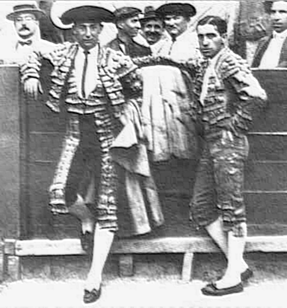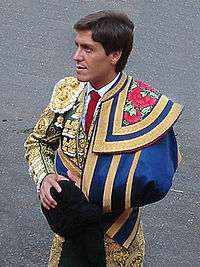Traje de luces



The traje de luces[1] (suit of lights) is the traditional clothing that Spanish bullfighters (toreros, picadors and rejoneadors) wear in the bullring. The term originates from the sequins and reflective threads of gold or silver. These trajes are based on the flamboyant costumes of the 18th-century dandies and showmen involved in tauromachia, which later became exclusive to the bullfighting ritual. Later adornments include the montera hat, elaborate embroidery and decorative accessories.
Toreros
Getting dressed to kill constitutes a ceremonious ritual by itself, the matador is attended by a squire (mozo de espadas) who helps him to get dressed, often according to a "lucky" ritual in the privacy of a hotel room.
Components of the traje de luces for a torero may include:
- Montera is the hat that the bullfighter and his assistants (subalterns) wear. The bullfighter dresses during paseíllo (presentation) and in first two-thirds of the ritual called suerte de varas (goading phase) and banderillas (lances phase). It may be offered to a spectator as a mark of honour following a tradition set by Paquiro (Francisco Montes Reina, a famous 19th-century torero).
- Castoreño is a wide-brimmed round hat made of white or beige beaver skin that is worn by picadors (lancer on horseback).
- Corbatín: The narrow black necktie.
- Chaquetilla: A short and rigid jacket, with shoulder reinforcements, attached only at the upper shoulder to allow the free and unimpeded movement of the arms.
- Taleguilla: The close-fitting tights which extend from the waist to underneath the knee, secured with tasseled cords or decorated gaiters. Taleguilla are supported by means of braces tirantes concealed by decorative and/or protective clothing.
- Medias two pairs of socks or stockings are used. Those of underneath they are white cotton, and the external pair are almost pink silk(sometimes white or red or black).
- Camisa: the plain white shirt, sometimes embroidered, worn beneath the chaquetilla is white.
- Zapatillas are the flat slippers similar to ballerinas and secured with a bow.
- Capote de paseo: a vestige of the 19th-century cape for promenading, this is a short silk mantle with rich and luxurious embroidery, which used during the paseíllo. Before the main performance starts, this ornate capote de paseo is exchanged for a more utilitarian red or purple muleta or long cape used to entice the bull to charge. This has stiff reinforcing rods at the sides (muleta also means crutch or cane in Spanish).
- Coleta: In the 19th century the bullfighters wore long hair often secured in a bun (called a moña) reminiscent of the 18th-century wigs. This was secured by the Coleta. Traditionally, the hair-bun was severed to indicate the torero was leaving the profession, since then, the bullfighters have tended to use a detachable hair adornment called a castañeta.
Picadors
Components of the traje de luces for a picador (the mounted goader).
- calzona de gamuza Boots made of chamois instead of slippers. Steel armour is worn on the right leg to avoid being gored (cornada) by the bull's horns.
- castoreño: A traditional beaver-skin hat.
- chaquetilla The picador's jacket is adorned with gold, a privilege reminiscent of times when the picador was equal to or more important than the matador.
Rejoneadores
Rejoneadores are mounted lancers who slaughter the bull whilst sitting on horseback. The Spanish rejoneadores use the traditional suit of Andalusian cattlemen, while the Portuguese rejoneadores dress in the style of Frederick II of Prussia, a fashion similar to 18th-century gentlemen-horseriders.
Goyaesque corridas
These bullfights celebrate the earliest versions of the modern ceremony, which evolved in the 18th century, and which were recorded by the painter Goya. The suit is similar to the conventional traje de luces, but with less adornment. the Taleguilla tights are more comfortable, being of silk with gold thread. Goyaesque toreros perform the paseíllo with a bicorne hat capote de brega (struggle cape) which is similar to the muleta, but in stiffer material, and without the stiffening rods.It measures between 113 & 123 cm and weighs some 4 – 6 kg. Bullfights in the style of Goya are known as Ronda, and are celebrated in Spain at the end of September, and also at Arles in France.
References
Notes
- ↑ Pedraza, Felipe (First published 2005). Iniciación a la fiesta de los toros # 4.4 El traje de torear (in Spanish). Biblioteca Edaf ISBN 978-84-414-0293-5. Check date values in:
|date=(help)
External links
| Wikimedia Commons has media related to Traje de luces. |
- Inventario web de trajes de luces (Spanish)
- Labeled diagram of a torero standing in his traje de luces (Spanish)
- assorted pictures of toreros in action (Spanish)